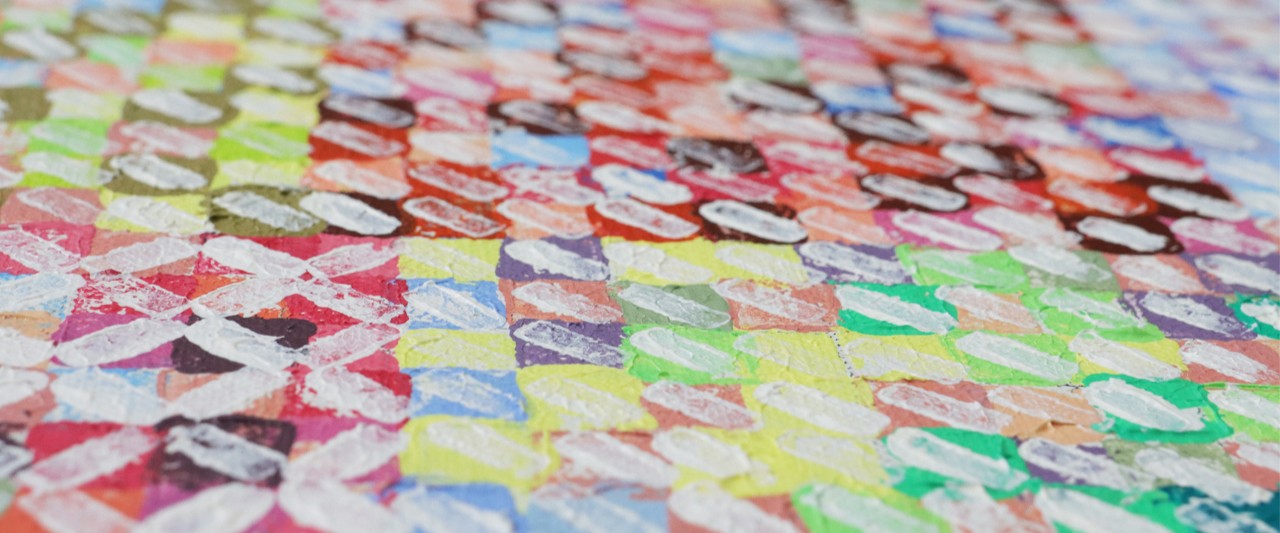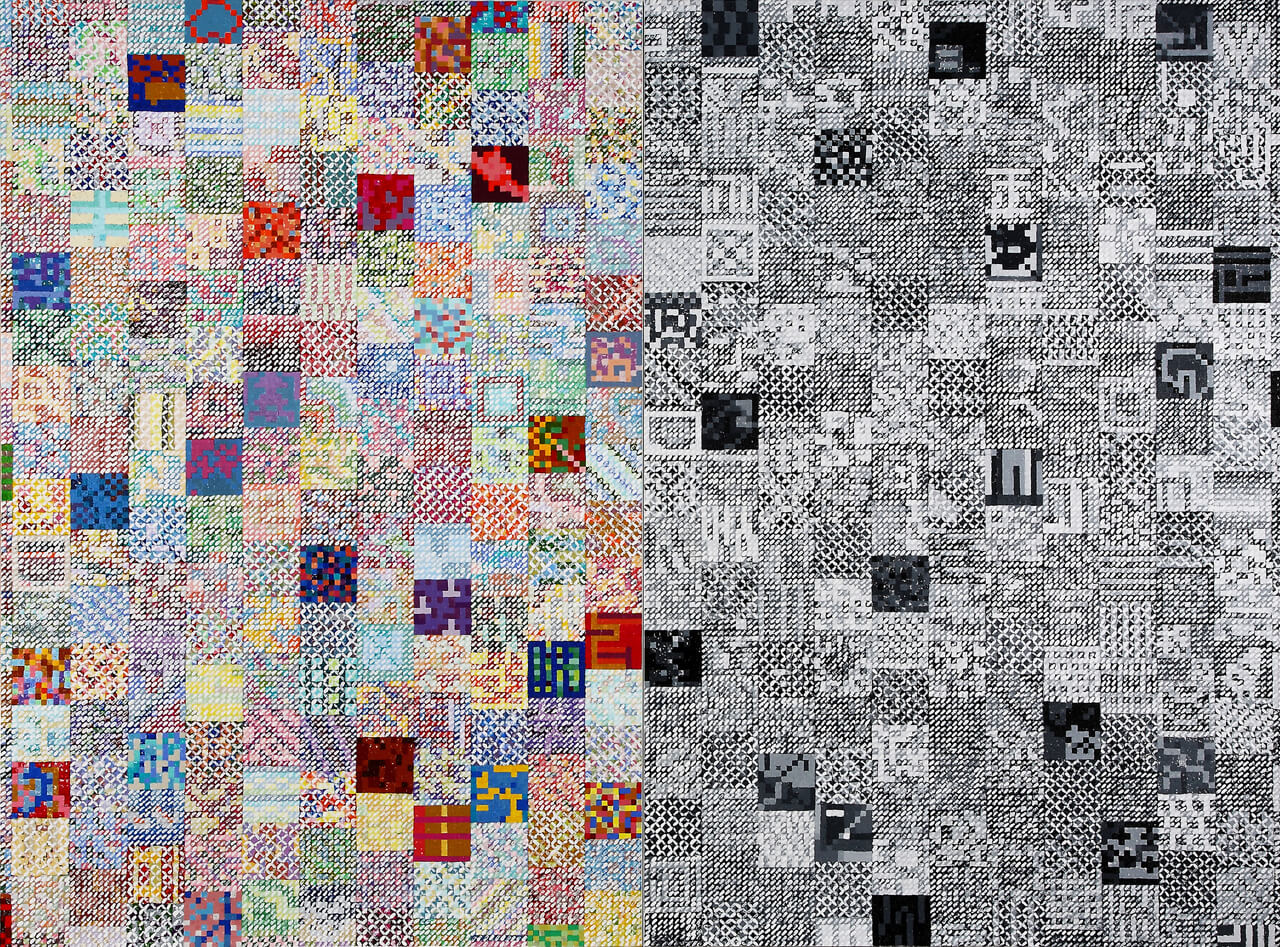|EXHIBITION
A Flood of Tender Water, I Take One Only
I Hate Takashi Murakami, I Hate Yoshitomo Nara
Chang Yi-Hsiung
From May 3-10, 2008, Tsong Pu will be showing solo exhibitions of new works at both “Main Trend Gallery” and “IT Park Gallery.” Print works based on the “Tsong Cun Method” shown in this exhibition highlight how a seemingly out of sync picture can come into focus almost unnoticed, by exhibiting a certain sense of color, brilliance and explosiveness, replete with uncertainty and possibilities. Unfortunately, visitors to IT Park Gallery might also find themselves irritated by an anonymous man wearing a brown paper bag decorated with Mickey Mouse ears and holding up two protest banners that read “I Hate Takashi Murakami, I Hate Yoshitomo Nara”. Once again we see the importance of humor in Tsong Pu’s diverse body of work.
Tsong’s seal works mark an attempt by the artist to move away from his habitual use of space. Instead he adopts an approach that eliminates the principles of perspective governing fixed and dispersed points. Tsong first paints countless regular squares on the canvas and then repeatedly “affixes seals” of similar patterns in a fixed selection of colors in each square, a repeated motion mapped out with an orderly rhythm. Tsong Pu believes that the manual manipulation of a piece turns it into a repository for the artist’s state of mind and emotions. As the prints fill up the space the pictures becomes increasingly complex and moves back from complex to simple, creating space in which the viewer’s imagination can roam at will. Finally, Tsong uses the covering of white seals to symbolize an act of deletion, a ritual act of elimination imbued with Zen Buddhist thought.
This exhibition displays a continuous piece Tsong continues to work on, a picture that is presented as cold and lacking in warmth. However, on this occasion the artist changes the homogeneous surface, adding different colors and indistinct shapes that create a visual center for the mosaic, providing a focal point and structure. As part of this, numbers depicting the era are also incorporated. Tsong Pu says: “In the past when I produced homogeneous seals, observers often tried to find things hidden in them and that I really didn’t know how to respond.” With this in mind, Tsong asked himself whether it is possible for a non-narrative work to include things with their own narrative nature? With the exception of still life pieces, the motivation to change the creative status quo is self evident and labeled 2008, a move that indicates how major changes in the external social and economic environment have impacted the inner world of the artist. As society has filled with raucous dissenting noise, Tsong Pu’s fragmentary ideas reflect his concerns which are then addressed through art. When seals are arranged together they create a compound rupture, like an explosion that extends outwards, emitting ray after ray of light. A picture of an explosion is an image of existing destruction, but it is impossible to know if something new will take shape in the aftermath of the carnage.
This exhibition also includes around 20 A4 paintings that showcase Tsong Pu’s powers of observation when it comes to materials. The unprocessed materials he habitually uses are detached from the act of “manufacturing” and transcend the scope of more traditional media, as the artist freely includes a variety of objects as his creative focus. This series adopts what could be referred to as a visual double entendre. For example, Tsong views matchsticks as the remains of dead trees imbued with images of bones and remains. Different images are later made with a different number of matchsticks ranging from 1-10. One resembles a cell phone on its side; two look like chopsticks, three underpants, four a credit card, five a house, six stars representing the future. The arrangement of a large number of soup spoons connected by a thread symbolizes the interconnection of lakes and rivers, but why then does the subject-object relationship in “One Spoon-full No More” come with a question mark? Marshall McLuhan once made a joke that detailed this phenomenon: “A young boy helps a nun across the road. She thanks the boy, but he responds unexpectedly. “It’s OK grandma, all Bat Man’s family are friends of mine.” ” The visual humor here is to be found in the fact that the outline and color of Bat Man’s cape resembles ever so slightly the habit worn by nuns. This joke has no story behind it, making it a double entendre that tests our ability to access and process image information. There is no story and no ending, just a request that one work out the puzzle oneself. In this context, the materials such as matchsticks and soup spoons used by Tsong Pu and their symbolic connection take people’s daily demand for desire and produce illogical substitutions and connections whilst utilizing ridiculous methods, deliberately harnessing the exchange of materials to facilitate a transformation of ideas.
The current exhibition at two different locations shows works created by Tsong Pu since the summer vacation of 2007. They still come infused with much habitual language but crucially the materials used and the methodology to convey meaning are very much different. Regardless of the process by which seals are affixed, the ritual nature of acetic self cultivation in Zen Buddhism or the weak connection between materials and other symbols, Tsong Pu is adept at controlling the explosive moment in the structure of his pieces. He carefully manipulates repetition, excess language and meaningless descriptions so that ultimately a language that is clean, simple and fast establishes a breakthrough - facilitating sudden realization.
+ Learn More
|M Show: BUY NOW|
|SOLO──Tsong Pu|
|
SOLO──Tsong Pu
|
+ Learn More
|m Space|
|Tsong Pu──The World Comes From “Something”|
⌈Every artist is keen to express himself/herself, insofar as to affect the majority viewpoint. Actually, it is little more than a utopian ideal of attempting the impossible or presenting something extremely onerous to present. Difficulties notwithstanding, I’m delighted to be the artist.|Tsong Pu⌋ |
⌈As far as I’m concerned, avant-garde is synonymous with subversion or revolution. Change your ways and you can change everything! Keep re-orientating yourself and you’ll blaze a trail!|Tsong Pu⌋ |
|
Tsong Pu──The World Comes From “Something”
|









